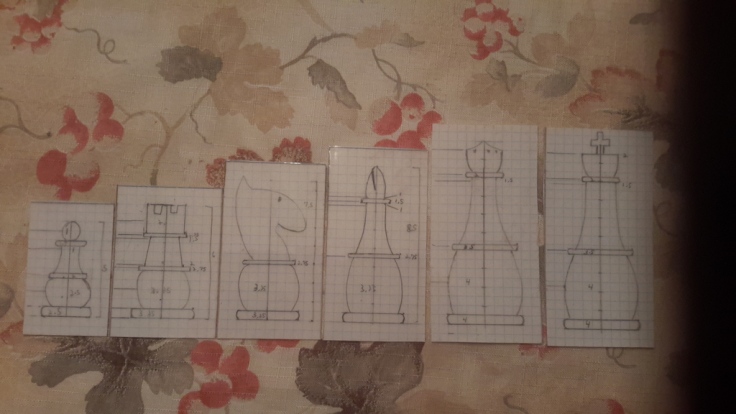Mike Darlow has produced a superb book on chess pieces that contains techniques as well as designs for inspiration purposes. One finds in the book much very important information, the main element being proper planning of the project. It is essential to think of the shape of the pieces, but also of size, materials, and of the signature of the pieces as part of the set.
Here are a few key elements to keep in mind…
The base of the pieces must be 50% to 80% of the size of the squares on the chessboard.
The pawns must be about 40% of the height of the king.
The pieces must share some similar feature, a shape or element that is found on all pieces to make them form a set.
The wood must be hard and dense so as to be able to take the detail turned in each piece.
The contrast in color between both sides must be sufficient to avoid any confusion during the game.
The weight of the pieces determines their value.
With these basic rules in mind, I started drawing my first set. I chose to go for a style that would not make each piece confusing, and went for dimensions at the base that would allow for lead inserts.
I drew my pieces on specialty caftspaper for measurement purposes. Here, one centimeter contains two squares, which gave me an idea of the overall appearance of the set. I then had my patterns plastified with the thickest plastic that was available at the store, and I cut all the patterns into rectangles.
Here they are:

Prior to turning, I cut the blocks to size, leaving an additional 1/4 in. per block to make the finishing of the tips easier. This excluded the rook, for which the blank was cut to exact length.
Then, on the drillpress, I drilled a 3/4 inch hole in the bases, with a depth of 1/2 in.
Finally, I drilled a hole in the center of the base with a regular drill bit to screw in my homemade chuck. That hole, in the center of the original 3/4 in. hole I had drilled with the forstner bit, was an additional 1 inch deep.
I mounted each piece on my wood chuck, which included a 3/4 inch jam section as well as a center screw. I will now move on to the turning of each piece, so please follow me as I go along!

Leave a comment